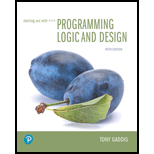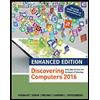
Starting Out with Programming Logic and Design (5th Edition) (What's New in Computer Science)
5th Edition
ISBN: 9780134801155
Author: Tony Gaddis
Publisher: PEARSON
expand_more
expand_more
format_list_bulleted
Question
Chapter 1, Problem 3E
Program Plan Intro
ASCII character Set:
The ASCII is stands for “American Standard Code for Information Interchange”.
- It uses 128 unique characters which represent the English letters, punctuation marks and other characters.
- It uses seven bits to represent each character in the set. Check bit is used as the eighth bit to ensure proper data transmission.
- Extended ASCII character version includes the eighth bit and allows 256 unique characters, which includes some additional symbols and some accented letters.
- ASCII has a finite number of characters; so it lists them all and assigns binary string value to each one of them.
- ASCII character set as well as Unicode character set treats uppercase and lowercase letters distinctly.
- For example, the ASCII code for A is 65. When “A” is typed on keyboard, its equivalent ASCII value “65" will be automatically stored in the memory.
Expert Solution & Answer
Want to see the full answer?
Check out a sample textbook solution
Students have asked these similar questions
2:21 m
Ο
21%
AlmaNet
WE ARE
HIRING
Experienced Freshers
Salesforce
Platform
Developer
APPLY NOW
SEND YOUR CV:
Email: hr.almanet@gmail.com
Contact: +91 6264643660
Visit: www.almanet.in
Locations: India, USA, UK, Vietnam
(Remote & Hybrid Options Available)
Provide a detailed explanation of the architecture on the diagram
hello please explain the architecture in the diagram below. thanks you
Chapter 1 Solutions
Starting Out with Programming Logic and Design (5th Edition) (What's New in Computer Science)
Ch. 1.2 - What is a program?Ch. 1.2 - What is hardware?Ch. 1.2 - List the five major components of a computer...Ch. 1.2 - What part of the computer actually runs programs?Ch. 1.2 - Prob. 1.5CPCh. 1.2 - Prob. 1.6CPCh. 1.2 - Prob. 1.7CPCh. 1.2 - Prob. 1.8CPCh. 1.3 - What amount of memory is enough to store a letter...Ch. 1.3 - Prob. 1.10CP
Ch. 1.3 - Prob. 1.11CPCh. 1.3 - Prob. 1.12CPCh. 1.3 - Prob. 1.13CPCh. 1.3 - Prob. 1.14CPCh. 1.4 - A CPU understands instructions that are written...Ch. 1.4 - Prob. 1.16CPCh. 1.4 - When a CPU executes the instructions in a program,...Ch. 1.4 - What is assembly language?Ch. 1.4 - What type of programming language allows you to...Ch. 1.4 - Prob. 1.20CPCh. 1.4 - What do you call a program that translates a...Ch. 1.4 - What do you call a program that both translates...Ch. 1.4 - Prob. 1.23CPCh. 1.5 - Prob. 1.24CPCh. 1.5 - Prob. 1.25CPCh. 1.5 - Word processing programs, spreadsheet programs,...Ch. 1 - A(n) _______ is a set of instructions that a...Ch. 1 - Prob. 2MCCh. 1 - Prob. 3MCCh. 1 - Today, CPUs are small chips known as ____. a....Ch. 1 - Prob. 5MCCh. 1 - Prob. 6MCCh. 1 - Prob. 7MCCh. 1 - Prob. 8MCCh. 1 - Prob. 9MCCh. 1 - Prob. 10MCCh. 1 - Prob. 11MCCh. 1 - In a(n) ______ numbering system, all numeric...Ch. 1 - A bit that is turned off represents the following...Ch. 1 - Prob. 14MCCh. 1 - Prob. 15MCCh. 1 - Prob. 16MCCh. 1 - Prob. 17MCCh. 1 - Prob. 18MCCh. 1 - Prob. 19MCCh. 1 - Prob. 20MCCh. 1 - Computers can only execute programs that are...Ch. 1 - Prob. 22MCCh. 1 - The words that make up a high-level programming...Ch. 1 - Prob. 24MCCh. 1 - A(n) _______ program translates a high-level...Ch. 1 - Today, CPUs are huge devices made of electrical...Ch. 1 - Prob. 2TFCh. 1 - Any piece of data that is stored in a computers...Ch. 1 - Prob. 4TFCh. 1 - Machine language is the only language that a CPU...Ch. 1 - Assembly language is considered a high-level...Ch. 1 - An interpreter is a program that both translates...Ch. 1 - A syntax error does not prevent a program from...Ch. 1 - Prob. 9TFCh. 1 - Word processing programs, spreadsheet programs,...Ch. 1 - Why is the CPU the most important component in a...Ch. 1 - Prob. 2SACh. 1 - Prob. 3SACh. 1 - What are the words that make up a high-level...Ch. 1 - What are the short words that are used in assembly...Ch. 1 - What is the difference between a compiler and an...Ch. 1 - Prob. 7SACh. 1 - Prob. 1ECh. 1 - Use what you've learned about the binary numbering...Ch. 1 - Prob. 3ECh. 1 - Use the Web to research the history of the BASIC,...
Knowledge Booster
Similar questions
- Complete the JavaScript function addPixels () to calculate the sum of pixelAmount and the given element's cssProperty value, and return the new "px" value. Ex: If helloElem's width is 150px, then calling addPixels (hello Elem, "width", 50) should return 150px + 50px = "200px". SHOW EXPECTED HTML JavaScript 1 function addPixels (element, cssProperty, pixelAmount) { 2 3 /* Your solution goes here *1 4 } 5 6 const helloElem = document.querySelector("# helloMessage"); 7 const newVal = addPixels (helloElem, "width", 50); 8 helloElem.style.setProperty("width", newVal); [arrow_forwardSolve in MATLABarrow_forwardHello please look at the attached picture. I need an detailed explanation of the architecturearrow_forward
- Information Security Risk and Vulnerability Assessment 1- Which TCP/IP protocol is used to convert the IP address to the Mac address? Explain 2-What popular switch feature allows you to create communication boundaries between systems connected to the switch3- what types of vulnerability directly related to the programmer of the software?4- Who ensures the entity implements appropriate security controls to protect an asset? Please do not use AI and add refrencearrow_forwardFind the voltage V0 across the 4K resistor using the mesh method or nodal analysis. Note: I have already simulated it and the value it should give is -1.714Varrow_forwardResolver por superposicionarrow_forward
- Describe three (3) Multiplexing techniques common for fiber optic linksarrow_forwardCould you help me to know features of the following concepts: - commercial CA - memory integrity - WMI filterarrow_forwardBriefly describe the issues involved in using ATM technology in Local Area Networksarrow_forward
- For this question you will perform two levels of quicksort on an array containing these numbers: 59 41 61 73 43 57 50 13 96 88 42 77 27 95 32 89 In the first blank, enter the array contents after the top level partition. In the second blank, enter the array contents after one more partition of the left-hand subarray resulting from the first partition. In the third blank, enter the array contents after one more partition of the right-hand subarray resulting from the first partition. Print the numbers with a single space between them. Use the algorithm we covered in class, in which the first element of the subarray is the partition value. Question 1 options: Blank # 1 Blank # 2 Blank # 3arrow_forward1. Transform the E-R diagram into a set of relations. Country_of Agent ID Agent H Holds Is_Reponsible_for Consignment Number $ Value May Contain Consignment Transports Container Destination Ф R Goes Off Container Number Size Vessel Voyage Registry Vessel ID Voyage_ID Tonnagearrow_forwardI want to solve 13.2 using matlab please helparrow_forward
arrow_back_ios
SEE MORE QUESTIONS
arrow_forward_ios
Recommended textbooks for you
 Enhanced Discovering Computers 2017 (Shelly Cashm...Computer ScienceISBN:9781305657458Author:Misty E. Vermaat, Susan L. Sebok, Steven M. Freund, Mark Frydenberg, Jennifer T. CampbellPublisher:Cengage Learning
Enhanced Discovering Computers 2017 (Shelly Cashm...Computer ScienceISBN:9781305657458Author:Misty E. Vermaat, Susan L. Sebok, Steven M. Freund, Mark Frydenberg, Jennifer T. CampbellPublisher:Cengage Learning Principles of Information Systems (MindTap Course...Computer ScienceISBN:9781285867168Author:Ralph Stair, George ReynoldsPublisher:Cengage Learning
Principles of Information Systems (MindTap Course...Computer ScienceISBN:9781285867168Author:Ralph Stair, George ReynoldsPublisher:Cengage Learning Systems ArchitectureComputer ScienceISBN:9781305080195Author:Stephen D. BurdPublisher:Cengage Learning
Systems ArchitectureComputer ScienceISBN:9781305080195Author:Stephen D. BurdPublisher:Cengage Learning C++ for Engineers and ScientistsComputer ScienceISBN:9781133187844Author:Bronson, Gary J.Publisher:Course Technology PtrNp Ms Office 365/Excel 2016 I NtermedComputer ScienceISBN:9781337508841Author:CareyPublisher:Cengage
C++ for Engineers and ScientistsComputer ScienceISBN:9781133187844Author:Bronson, Gary J.Publisher:Course Technology PtrNp Ms Office 365/Excel 2016 I NtermedComputer ScienceISBN:9781337508841Author:CareyPublisher:Cengage

Enhanced Discovering Computers 2017 (Shelly Cashm...
Computer Science
ISBN:9781305657458
Author:Misty E. Vermaat, Susan L. Sebok, Steven M. Freund, Mark Frydenberg, Jennifer T. Campbell
Publisher:Cengage Learning

Principles of Information Systems (MindTap Course...
Computer Science
ISBN:9781285867168
Author:Ralph Stair, George Reynolds
Publisher:Cengage Learning

Systems Architecture
Computer Science
ISBN:9781305080195
Author:Stephen D. Burd
Publisher:Cengage Learning

C++ for Engineers and Scientists
Computer Science
ISBN:9781133187844
Author:Bronson, Gary J.
Publisher:Course Technology Ptr


Np Ms Office 365/Excel 2016 I Ntermed
Computer Science
ISBN:9781337508841
Author:Carey
Publisher:Cengage